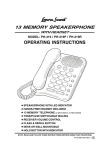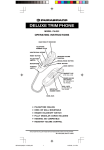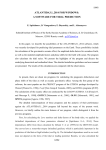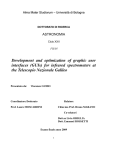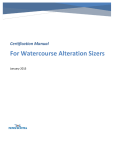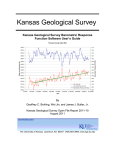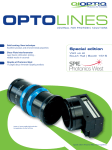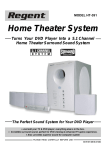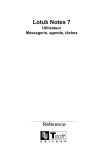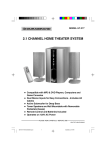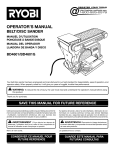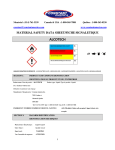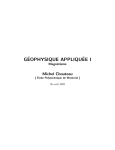Download Tsoft: graphical and interactive software for the analysis of time
Transcript
ARTICLE IN PRESS Computers & Geosciences 31 (2005) 631–640 www.elsevier.com/locate/cageo Tsoft: graphical and interactive software for the analysis of time series and Earth tides$ Michel Van Camp, Paul Vauterin1 Royal Observatory of Belgium, Avenue Circulaire, 3, BE-1180 Brussels, Belgium Received 23 January 2004; received in revised form 22 November 2004 Abstract We present Tsoft, a graphical interactive analysis software package originally dedicated to the analysis and processing of gravity time series. Tsoft can also be used to process and analyze all sorts of time series like seismic or other environmental signals. The Tsoft approach has a number of important advantages in the area of pre-treatment of the data (correction of artefacts such as spikes and steps), because the user can always inspect what happened and intervene manually. The graphical environment is also very convenient for the detection, isolation and analysis of events (e.g. earthquakes). Lastly, errors in the analysis path are easily detected, because the software shows a graphical representation of the results at each stage of the analysis. In this article we describe first the general data structure and the possible data manipulations and computations. Then, we present the correcting tools dealing with unwanted steps, spikes and gaps in raw data. Afterwards, we describe the module dedicated to the computation of tidal signals. Lastly, we give an overview of the most used computing tools like spectral analysis and multilinear least-squares fit. r 2004 Elsevier Ltd. All rights reserved. Keywords: Time series analysis; Signal processing; Environmental data; Tides; Gravity 1. Introduction Since 1997, the Royal Observatory of Belgium has developed a graphical and interactive analysis software package, called ‘‘Tsoft’’ (Vauterin, 1998). It is dedicated to the analysis of time series with a special stress on some geophysical (e.g. gravity) and environmental data. $ Code available from server at http://www.iamg.org/CGEditor/index.htm or from http://www.astro.oma.be/SEISMO/ TSOFT/tsoft.html. Corresponding author. Tel.: +322 373 0265; fax:+322 373 0339. E-mail address: [email protected] (M. Van Camp). 1 Applied Maths BVBA, Keistraat 120, BE-9830 SintMartens-Latem, Belgium. The user visualizes the data graphically at each stage of the processing and is therefore able to work in a fully interactive way. This methodology, supported by the graphic capabilities of the software, makes it possible to detect, isolate and analyze special events in the series (e.g. seismic free oscillations in gravity or seismic data). It also allows the user to detect possible errors early in the analysis path. Tsoft contains a large set of numerical analysis tools like FFT spectrum calculation, low-, high- and bandpass filters, multilinear regressions, determination of transfer functions, etc. Tsoft allows the user to calculate tidal parameters and synthetic tidal signals, which is useful for any gravity measurements. Lastly, Tsoft offers the possibility to write scripts, allowing one to automate and speed up routine tasks considerably. 0098-3004/$ - see front matter r 2004 Elsevier Ltd. All rights reserved. doi:10.1016/j.cageo.2004.11.015 ARTICLE IN PRESS 632 M. Van Camp, P. Vauterin / Computers & Geosciences 31 (2005) 631–640 Tsoft runs on PCs using Windows 95, 98, 2000, XP or NT. This public domain software and its user manual can be downloaded freely from the Royal Observatory web site.2 possible. Different sub-windows are also opened when needed. Moreover, the user can specify active and inactive data using the mouse: most of the calculations performed by Tsoft acts only on the active part of the activated channel. The results of the calculations can be exported in a text file. 2. Data structure and input/output To a given data set there corresponds a sample frame, which is a series of moments on the time scale beginning at an initial time and regularly spaced by a duration called sample rate. Tsoft accepts sample rates from 0.001 s up to 69 years, which is also the longest possible data series. A Tsoft data set consists of several channels (up to several dozens). The length of the data set, and therefore the number of values per channel, is only limited by the memory capacities of the PC. The channels are identified and sorted by location, instrument, measurement and unit, which refer to their data. Data sets are mostly loaded from data files but it is also possible to create a data set from scratch, specifying its time interval and sample rate. This allows theoretical computations and is especially useful to predict synthetic and theoretical Earth tides (see Section 8). When loading data sets from files several formats are accepted; beside its own ‘‘Tsoft format’’ (.TSF files), in ASCII, Tsoft also accepts several other formats such as GSE, a standard format in seismology, (PR)ETERNA, so named from the Earth tides analysis software (Wenzel, 1996a), widely used for gravity data, and the commercial format EVT, the Kinemetrics format for strong motion instruments. Tsoft also accepts any ASCII free format. It is also possible to append several files each to the others so that the user can gather them to form one data set. When saving data sets the ‘‘Tsoft format’’ is preferred because a lot of metadata is saved over the data values: identification of the channels, correctors (Section 7). However, it is also possible to save the data into the (PR)ETERNA formats in order to ensure compatibility with the ETERNA software. Finally, one can also export the values of the selected channels only in a file of which the format is currently accepted by many graphical softwares. 3. Visualization and general manipulation of files In the Tsoft application window, the left pane is devoted to the metadata: identification, display and selection of channels while the right pane displays the curves corresponding to the data. The user may act interactively in both panes and zooming in and out is 2 Royal Observatory of Belgium. 2004. http://www.astro. oma.be/SEISMO/TSOFT/tsoft.html. 4. Operations on channels The user can manipulate the channels easily (rename, delete, create, duplicate) and assign to a channel the result of arithmetical expressions, containing standard operators and functions and wherein the other channels can be operands. A channel can contain ‘‘gaps’’ or ‘‘missing values’’ and Tsoft has the advantage to handle them in an easy and consistent way: the result of operations with these missing or ‘‘undetermined’’ values is simply ‘‘undetermined’’, allowing further computations without producing errors. Beside arithmetical operations Tsoft can also apply time shifts to a channel, and compute time integrations and derivatives; the results are stored in a new channel. 5. Filtering channels: FFT, LSQ and butterworth filters Tsoft offers one filter applied in the frequency domain (Fast Fourier Transform (FFT) filter) and two in the time domain (Least Squares (LSQ) and 2-poles Butterworth filters). For all types, low-pass, high-pass and band-pass filters are available. 5.1. FFT filter For the finite impulse response (FIR) FFT filter, the user enters two parameters: the cut-off frequency and the band width. The algorithm includes the following steps: 1. the FFT transform of the signal is calculated; 2. this transform is multiplied by a given filter response function in the frequency domain; 3. the resulting transform is transformed back into the time domain. As each point of the filtered signal depends on all points of the filtered channel, the results are slightly influenced by the limitations in time of the series and by the presence of gaps. Therefore, the FFT filter should not be used as anti-aliasing filter in the routine decimation of the data, but rather as a powerful tool for analysis and investigation of the data. ARTICLE IN PRESS M. Van Camp, P. Vauterin / Computers & Geosciences 31 (2005) 631–640 5.2. LSQ filter The principle of the LSQ approach is to find a transfer function which minimizes the total approximation error. This error is calculated from the difference between the actual and the desired (‘‘brick-wall’’) filter impulse response in the time domain (Bloomfield, 1976). Two parameters must be provided: the cut-off frequency and the number of points of the filter. Provided they are carefully chosen, the Gibbs’s phenomenon affecting the transfer function (overshoot and ripples on either side of the cut-off frequency) can be greatly reduced. Because of its very good frequency response properties, the LSQ filtering is an appropriate choice as an anti-aliasing filter to decimate a signal. For example, before the decimation of a 1 min sample interval to a 1 h sample interval, a LSQ filter with cut-off frequency of 12 cycles per day and window size of 480 points can be applied. This filter has a total length of 16 h and the frequency response curve deviates in the tidal frequency band by less than 0.05% from unity. 5.3. Butterworth filter The Infinite Impulse Response (IIR) Butterworth filter has an overall monotonic response, decreasing smoothly (Kulhanek, 1976). The amplitude response does not have any ripple, either inside or outside the pass band. However, the causal Butterworth filter has nonlinear phase, but does not cause any time delay: this is very useful when measuring seismic phase arrival times (Scherbaum, 2001) but not suitable for tidal analysis as measuring the phases of the different tidal waves is important to evaluate recent Earth models (Van Camp et al., 2000; Baker and Bos, 2003). For this purpose, non-causal FIR filters are preferred because they do not cause any phase distortions of the signal and produce a constant time shift over the whole frequency band, which can be accounted for. Designing filters is beyond the scope of Tsoft; for detailed studies one should use another software like MATLABr. However, Tsoft allows the user to check the filter transfer functions easily by creating a step function, applying the filter and using the transfer function command; the latter was used to determine the transfer function of superconducting gravimeters using step functions (Van Camp et al., 2000). Another possibility to investigate the amplitude response is to apply the filter on a Gaussian white noise which can be generated by Tsoft, and then to apply the spectral analysis tool. 6. Changing data frames The sample frame can be shifted and its sample rate can be changed. If the new sampling interval is longer than the 633 original one (decimation), Tsoft proposes to apply a LSQ filter, necessary to avoid aliasing (Bloomfield, 1976). Another possibility is ‘‘Cumulative’’, which adds all the data included in the new sampling interval. This is useful e.g. to decimate rainfall data. On the other hand, if the time interval becomes smaller (oversampling), a linear or cubic interpolation is used to create new points. 7. Correctors Raw time series such as long period seismic or gravity recordings can contain undesired events such as spikes, steps, or gaps (missing data). Other events with a geophysical origin, such as earthquakes recorded in gravity or long period seismic measurements, can also cause severe deviations and saturations of the signal for periods up to a few hours. Whether they are due to instrumental problems or have a geophysical origin, these events may corrupt further signal analyses. Moreover, in most circumstances, one cannot just replace the undesired event with missing data. A gap, even one single value, also severely corrupts frequency analysis processes or causes a large gap after decimating the data, due to the anti-aliasing filter. Therefore, it is usually preferable to correct events by interpolating the data, at least for short time periods. Tsoft unifies two approaches for the correction of perturbations. On the one hand, the programme automatically searches for perturbations in the signal and proposes corrections; but on the other hand, the user can inspect and modify the proposals before applying them. For this purpose Tsoft uses the concept of ‘‘corrector’’. They can be of four types: (1) linear interpolations, replacing the data points during a certain time interval by a linear function; (2) cubic spline interpolations, replacing the data by a third degree polynomial; (3) steps, using a constant value to all data points after a given moment in time; or (4) gaps, removing all points during a certain time period. In the last case, gaps are considered as undetermined values in the data files. In the first step Tsoft searches for the irregular events corresponding to the parameters and detection threshold given by the user and it creates a corrector for each event detected. The correctors, still in an unapplied state, can be inspected visually and modified by the user who can also add or delete some and finally instruct Tsoft which ones are to be applied or not. The information contained in the correctors is saved as metadata in the file allowing the user to investigate the correction process again and, if necessary, to re-edit the applied corrections in the future. The advantage of this method is to offer a fast, objective way of processing the data, while the user still keeps full control over the adjustments made, and can, at any moment, override them manually. This is very important, because there will always be (strong) perturbations in ARTICLE IN PRESS 634 M. Van Camp, P. Vauterin / Computers & Geosciences 31 (2005) 631–640 complex situations that are not handled correctly by no interactive automated algorithms (Vetter and Wenzel, 1995; Harnisch and Harnisch, 1997). Fig. 1 shows an example of some correctors on the superconducting gravimeter GWR-C021 recording (Francis et al., 2004), in an un-applied then in an applied state. 7.1. Spikes detection The detection method uses the following parameters which can be adjusted by the user: D; the minimum deviation a spike should have; W ; the window size; E; the spike envelope; F ; the minimum spike/slope ratio. Suppose that Ai are the data points (i ranging from 0 to n 1): 1. A low-pass filter FL is applied to the data points. This filter has a total length of 2W 1; and has coefficients that decrease linearly towards the end (e.g. for W ¼ 5; the filter points are 1/25, 2/25, 3/25, 4/25, 5/25, 4/25, 3/25, 2/25 and 1/25). These filtered data points are stored in an intermediate channel Bi : 2. For each point i where the absolute value jAi Bi j4D; Ai is replaced by Bi : The same filter FL is applied a second time on Ai ; and the result is again stored in Bi : This complete manipulation is repeated twice (which proved to be sufficient to have a good convergence). The reason for this step is that very aberrant points could bias the low-pass channel B i too much. Using this step, the spikes are already left out of the calculation. 3. All the zones on the channel where jAi Bi j4D are searched on the signal. Each individual zone is enlarged at both edges with a number of points E: If two zones turn out to be neighbouring or even overlapping, they are merged into one single, larger zone. 4. For each zone, a linear interpolation corrector is created covering the whole zone, using the values of Bi at both ends. Fig. 1. Computer display of GWR C021 gravity residuals and some correctors, before (grey) and after (black) application of correctors. Left: cubic spline interpolation applied to remove earthquake effects. Middle-left and right: linear interpolations. Middleright: corrected step (induced by a liquid helium filling). These gravity residuals are calculated from gravity data shown on Fig. 3. ARTICLE IN PRESS M. Van Camp, P. Vauterin / Computers & Geosciences 31 (2005) 631–640 5. For each interpolation, the maximum deviation from the interpolation d max is calculated, as well as the absolute value of the difference between the start and end points, d s : If d max =d s oF , the interpolation is rejected (because it rather resembles a step). 7.2. Gaps detection The algorithm uses the following set of parameters, which can be chosen by the user: The interpolation type T; which can be 1. 2. 3. 4. 5. 1. straight connection of points using a linear interpolation; 2. using a linear interpolation on fitted points; 3. using a cubic interpolation on fitted points, W ; the window size; d; the polynomial degree; L; the maximum gap length (in data points). Suppose that Ai are the data points (i ranging from 0 to n 1): All the gaps are detected. If T ¼ 1; the last point before each gap and the first point after it are used to create linear interpolations and the algorithm stops. If T41; for each gap, two polynomials of degree d are fitted, one (called P1) on the last W points before, and another (called P2) on the first W points after the gap. If one of the polynomials cannot be fitted (e.g. because the gap occurs at the end of the file), it is assumed to have a constant value which is equal to the closest value of the other polynomial. If T ¼ 2; a linear interpolation is created using the value of P1 at the start of the gap, together with the value of P2 at the end of the gap. If T ¼ 3; a third degree polynomial interpolation is created, using the value of P1 at the start of the gap and its first derivative, together with the value of P2 at the end of the gap and its first derivative. 7.3. Steps detection The algorithm uses the following set of parameters, which can be chosen by the user: D; the minimum deviation; W ; the window size; V ; the exclude window size. Suppose that Ai are the data points (i ranging from 0 to n 1): 1. At each point pj of the curve, a multilinear regression is performed using a first degree polynomial and a 635 step function SðtÞ; ðSðtÞ ¼ 0:5 for points to the left of pj ; and SðtÞ ¼ þ0:5 for the other ones). This fit is performed inside a window of 2W þ 1 points around the point pj ; excluding a small window of 2V þ 1 points around pj : This exclusion window is used to disregard intermediate points when a step is occurring rather slowly. The regression coefficient of SðtÞ is stored in a temporary channel Bi : 2. All the zones where jBi j4D are identified. Each zone is enlarged with an envelope of W points (because each step causes side lobes in Bi with negative signs), and overlapping zones are merged. 3. For each zone, a step corrector is created having a step value, which is the maximum of Bi inside that zone. 8. Computing tides and tidal residuals 8.1. Computing tides The Sun and the Moon exert tidal accelerations with maximal peak to peak amplitudes of 2500 nm/s2 (1 nm/ s2 ¼ 1 mGal). This is the most important signal affecting gravity measurements, if we exemt transient seismic perturbations. The calculation of tidal phenomena requires a representation of the tidal potential which is based on the relative position of the Moon, the Sun and the planets (Wenzel, 1996a). As the Earth is not a homogeneous and perfectly rigid body, it reacts to the astronomical forcing in a complex way. The response of the Earth to this excitation can be separated in deformations (the body tides), changes in the Earth’s orientation in space (forced nutation and precession) and changes in the Earth’s rotation rate (Wahr, 1981). Some of the most important tidal parameters are the frequencydependent tidal gravimetric factor d and the phase lead k: In the frequency domain, d is the transfer function between the tidal force exerted along the perpendicular to the ellipsoid and the tidal gravity changes along the vertical as measured by a gravimeter (Dehant et al., 1999). It depends on the direct attraction of the celestial bodies, on the Earth’s deformation and on the consecutive mass redistribution inside the Earth. The lead k represents the phase difference between the observed wave and the astronomical wave. A perfectly elastic Earth model provides d ffi 1:16 and k ¼ 0: Tidal parameter sets d and k can be deduced from observations or numerical models for each frequency of the tidal force. Tsoft uses the Tamura (1987) potential catalogue containing 1200 waves and is accurate to a 0.6 nm/s2 maximum error in time domain (Wenzel, 1996b; Roosbeek, 1996). This widely fulfils the accuracy requirements to correct gravity measurements, even from superconducting gravimeters (Francis, 1997; Van ARTICLE IN PRESS 636 M. Van Camp, P. Vauterin / Computers & Geosciences 31 (2005) 631–640 Dam and Francis, 1998). For a given location Tsoft can compute the time series from a tidal parameter set provided either by the user (e.g. after performing a tidal analysis on gravity recordings) or by Earth models. Tsoft itself can provide accurate frequency dependant tidal parameter sets from the Wahr–Dehant latitudedependent model (Dehant et al., 1999) taking into account the nearly diurnal free wobble, the inertial effect, the Coriolis force, the Earth’s flattening and anelasticity. The problem is complicated however by the ocean tides, which cause additional variations of g at the same frequencies but with different phases than the Earth tide. For example, this ocean tide attraction and loading effect reaches several mGal in amplitude for the M2 semi-diurnal wave in Western Europe. Accurate models provide now specific tidal parameter sets corresponding to the ocean tides effect. In the near future we plan to include a tool in Tsoft that will calculate these sets using the Schwiderski, FES, CSR, GOT, NAO or TPX models (Baker and Bos, 2003). A location database, included in Tsoft can store, for each station, its location, multiple tidal parameter sets as well for solid Earth as for ocean loading (Fig. 2). signal, which is useful e.g. for field gravity measurements, study of the Earth’s free oscillations or to apply the ‘‘remove–restore’’ technique. In this technique wellknown signals of large amplitude (computed synthetic tide and air pressure effects) are first removed from the gravity signal producing a residual signal where very small events at the nm/s2 level (steps, spikes, gaps) can easily be isolated and corrected (see Section 7). The removed signals are then restored to the cleaned residuals (Fig. 3). The successive steps of this procedure can be automated within a single script, making Tsoft a very powerful tool to compute gravity residuals and clean them. The data produced in this way may be used for the study of the residuals, such as the long-term gravity trend, or for Earth tides analyses. Notice that Tsoft does not perform any tidal analysis, for which one should use specific softwares like ETERNA (Wenzel, 1996a) or VAV/2000 (Venedikov et al., 2001). 9. Computing tools 8.2. Calculation of tidal residuals 9.1. Calibrations, transfer function, instrument oriented data base Thanks to its ability to compute accurate tides, Tsoft is very useful to correct gravity recordings from the tidal Tsoft includes a database which simplifies the organization of the different files containing recordings Fig. 2. Location data base used to calculate synthetic tides. Each station is described by a text identification, longitude, latitude and elevation. Right pane of window shows tidal parameter sets that have been inserted for currently selected station (here: Membach). New stations and tidal parameter sets can be created or modified by simple clicking in menu. ARTICLE IN PRESS M. Van Camp, P. Vauterin / Computers & Geosciences 31 (2005) 631–640 637 Fig. 3. Calculation of gravity residuals shown in Fig. 1. Up: raw calibrated gravity recording (black) and synthetic tide signal (grey). Middle: barometric recording. Bottom: gravity residual obtained by removing from raw data synthetic tidal signal and barometric signal multiplied by a linear admittance factor of 3.3 nm s2 hPa1. This value was determined by simultaneously fitting tidal parameters and local air pressure in a least-squares adjustment (Francis et al., 2004). from various instruments, as well as some other important parameters such as calibration information. The instrument database may contain five different types of information related to an instrument: installations, calibrations, time shifts, steps and file information (Fig. 4). ‘‘Time ‘‘Installations’’ contains the instrument and location names, the data and the time. allows one to apply time-dependent calibration, using a nonlinear calibration function. Each time an instrument has been calibrated, the user can enter its calibration function into the software’s data base, in the form of a general mathematical expression. A cubic spline interpolation between these known points is then applied in order to perform a time-dependent calibration of each individual data point. ‘‘Calibration’’ shift’’ deals with time-dependent shifts, which may be due to instrumental instabilities or to timing errors (e.g. a drifting clock). Whenever the exact shift of an instrument was determined, the user can enter the corresponding value in the data base. A cubic spline interpolation is applied on these points in order to obtain the phase shifts in-between. The programme further applies this time-dependent shift to the observational data points, by shifting each point over the appropriate time interval. Of course, this time shift will in general not be an integer multiple of the sampling interval. Therefore, a quadratic interpolation is used in order to get values between the sampled points. ‘‘Steps’’ allows one to store the steps that occurred on a data channel, by specifying the instrument and measurements, the data and the step value. Finally, ‘‘File information’’ contains, for a given instrument and measurement, a list of the relevant data files. ARTICLE IN PRESS M. Van Camp, P. Vauterin / Computers & Geosciences 31 (2005) 631–640 638 Fig. 4. Instrument database. At bottom of window, there is a time bar where files and events are marked. 9.2. Spectral analysis Tsoft calculates spectra and presents the amplitudes in a linear or logarithmic plot, with frequencies in hertz or cycles per day (Fig. 5). The software uses FFT to calculate the spectrum, padding the data with constant values up to a power of 2, and using (multiple) Hanning, Parzen or Square window functions (Bloomfield, 1976). It is also possible to calculate phase and power spectra. In addition, one can compute a series of spectra corresponding to a series of time windows of duration tw moving successively all over the length of the selected channel with a fixed time shift ts ; tw and ts being determined by the user. The result is a frequency against time array plot where colours represent the amplitude of the frequency and refer to an adjustable scale included in the sub-window. as a linear combination of orthogonal Chebycheff polynomials. This alternative returns the same drift result, but it is highly recommended for high degrees ðp44Þ; because it drastically improves the stability of the LSQ fit. The users choose the power n for the channel and the degree p and type (Chebycheff or not) of the polynomial time drift. Upon completion of the calculations, the correlation matrix, the fit coefficients of each component, i.e. aij and bk ði ¼ 1; . . . ; n; j ¼ 1; . . . ; m; k ¼ 1; . . . ; pÞ; with their estimated error and the residual standard deviation are displayed in the text output window and can be exported in a text file. In addition, two new channels are created: 1. The fit to the objective channel (‘‘fit’’). 2. The residuals of the fit ( ¼ objective channel minus the fit result) (‘‘resid’’). 9.3. Multilinear least-squares fits The aim of this fit is to try to express an objective channel chobj as a linear combination of a set of m component channels chc and their power n so that the square of the residuals RðtÞ is minimized. chobj ðtÞ ¼ m X n X j¼1 i¼1 aij chcij ðtÞ þ p X k bk t þ RðtÞ; k¼0 where chcij is the jth channelP at the power i; by default, n ¼ 1: The drift polynomial pk¼0 bk tk can be expressed 9.3.1. Advanced applications of multiple LSQ fits The specific tool dedicated to the computation of the vertical gravity gradient using spring gravimeter measurements is based on the multilinear leastsquares fit: the gravity is the objective channel and the component channel is the levels where measurements are made. It is possible to fit a temporal drift (linear, quadratic, etc.), as well as height dependence ARTICLE IN PRESS M. Van Camp, P. Vauterin / Computers & Geosciences 31 (2005) 631–640 639 Fig. 5. Amplitude spectrum and recording of LaCoste Romberg spring gravimeter ET-19 measuring at Black Forest observatory (BFO, Germany). Spectrum calculated on active data only (in black; inactive data are in grey), from 5h50 to 85h after 1998-03-25 Balleny Island Earthquake (from Van Camp, 1999). (only linear or quadratic). The text output window gives the gradient (at the levels of 65 and 90 cm required by absolute gravity measurements (Vitushkin et al., 2002 ) if the height dependence is quadratic) and statistical information. Tsoft also provides a very useful tool: the Moving Window Multilinear Least Squares fits. Here, a window of length tw moves through the time axis of the data set by successive shifts of length ts ; tw and ts being chosen by the user. A multilinear regression is performed for every window and the coefficients, varying in time, are available in new channels. Moreover, the possibility is offered to apply a frequency filter on the data before performing the regressions. In many cases the regression coefficient of a component channel is frequency-dependent. Therefore, Tsoft provides a ‘‘frequency-dependent multilinear least squares’’ fit. The idea is to apply to all channels a set of narrow FFT or LSQ band-pass filters over a range of frequencies. The different values of the coefficients corresponding to different frequencies then reflect the dependency on the frequency. These last two applications of multi-LSQ fits proved to be very useful in gravimetry. They can be applied to study the influence of environmental parameters, such as the effect of the local air pressure admittance on gravity data and its time or frequency dependence. Also, the variability of the sensitivity of a gravimeter, and its phase lag can be controlled by fitting the observed tide to a synthetic tide and its time derivative. 9.4. Other time tools It is possible to calculate the first derivative and time integration of a channel with respect to the time. The result is stored in a new channel. The Time shift tool shifts the highlighted channel in time over a specified number of seconds. The software also calculates the time correlation between two channels using the least-squares fit; this is useful to search the time delay between two channels. One channel is time shifted from t to þt and for each step a correlation coefficient is calculated. All these coefficients are plotted in a graph. A dialog box prompts for 2t and þt: ARTICLE IN PRESS 640 M. Van Camp, P. Vauterin / Computers & Geosciences 31 (2005) 631–640 Finally, it is possible to draw a histogram and to obtain the mean, the standard deviation and the intervals where 68%, 95.5% and 99.7% of the results lie. 10. Conclusions Tsoft is a graphical and interactive software for the processing of time series like seismic, gravity, temperature, pressure or water levels recordings. As these environmental data are mostly interdependent, Tsoft is a powerful tool as it allows general manipulations of the data channels, such as the possibility to easily fill a particular channel with a mathematical expression of the other data channels. Moreover, this software provides a wealth of common signal processing applications as well as advanced ones especially dedicated to gravity data. On the other hand, Tsoft is also dedicated to the correction of raw data. The possibility to intervene manually in an automatic data correction system is a prerequisite for any high-quality data processing method, because there will always be perturbations in complex situations that are not handled correctly by automatic algorithms. In Tsoft, this manual intervention is as convenient and as flexible as possible. Moreover, the software allows one to re-inspect and re-edit the corrections at any time, as these are saved together with the data. In addition, it contains advanced calibration routines, which can handle any general, time-dependent nonlinear calibration factors. Acknowledgments We are grateful to Marc Hendrickx for his fruitful comments and suggestions. We thank Henri Martin for helping us in the C++ programming. We are indebted to Olivier Francis for his fruitful collaboration concerning the tidal tools, and to the Tsoft users for their numerous suggestions and their patience. References Baker, T., Bos, M.S., 2003. Validating Earth and ocean tide models using tidal gravity measurements. Geophysical Journal International 152, 468–485. Bloomfield, P., 1976. Fourier Analysis of Time Series: An Introduction. Wiley, New York 258pp. Dehant, V., Defraigne, P., Wahr, J.M., 1999. Tides for a convective Earth. Journal of Geophysical Research 104 (B1), 1035–1058. Francis, O., 1997. Calibration of the C021 superconducting gravimeter in Membach (Belgium) using 47 days of absolute gravity measurements. International Association of Geodesy Symposia, vol. 117. Springer, Berlin, pp. 212–219. Francis, O., Van Camp, M., van Dam, T., Warnant, R., Hendrickx, M., 2004. Indication of the uplift of the Ardenne in long term gravity variations in Membach (Belgium). Geophysical Journal International 158, 346–352. Harnisch, M., Harnisch, G., 1997. Longtime behaviour of superconducting gravimeters derived from observed time series. Bulletin d’Information des Marées Terrestres 127, 9796–9805. Kulhanek, O., 1976. Introduction to Digital Filtering in Geophysics. Elsevier, Amsterdam 168pp. Roosbeek, F., 1996. RATPG95: a harmonic development of the tide-generating potential using an analytical method. Geophysical Journal International 126, 197–204. Scherbaum, F., 2001. Of Poles and Zeros, Fundamentals of Digital Seismology, second ed. Kluwer Academic Publishers, Dordrecht 265pp. Tamura, Y., 1987. A harmonic development of the tidegenerating potential. Bulletin d’Information des Marées Terrestres 99, 6813–6855. Van Camp, M., 1999. Measuring seismic normal modes with the GWR C021 superconducting gravimeter. Physics of the Earth and Planetary Interiors 116, 81–92. Van Camp, M., Wenzel, H.-G., Schott, P., Vauterin, P., Francis, O., 2000. Accurate transfer function determination for superconducting gravimeters. Geophysical Research Letters 27 (1), 37–40. Van Dam, T.M., Francis, O., 1998. Two years of continuous measurements of tidal and nontidal variations of gravity in Boulder, Colorado. Geophysical Research Letters 25 (3), 393–396. Vauterin, P., 1998. Tsoft: graphical and interactive software for the analysis of Earth tides data. In: Proceedings, 13th International Symposium on Earth Tides. Observatoire Royal de Belgique, Série Géophysique, Brussels, pp. 447–454. Venedikov, A.P., Arnoso, J., Vieira, R., 2001. Program VAV/2000 for tidal analysis of unevenly spaced data with irregular drift. Journal of the Geodetic Society of Japan 47 (1), 281–286. Vetter, M., Wenzel, H.-G., 1995. PREGRED: an interactive graphical editor for digitally recorded tidal data. Bulletin d’Information des Marées Terrestres 121, 9102–9107. Vitushkin, L., Becker, M., Jiang, Z., Francis, O., van Dam, T.M., Faller, J., Chartier, J.-M., Amalvict, M., Bonvalot, S., Debeglia, S., Desogus, S., Diament, M., Dupont, F., Falk, R., Gabalda, G., Gagnon, C.G.L., Gattacceca, T., Germak, A., Hinderer, J., Jamet, O., Jeffries, G., Käter, R., Kopaev, A., Liard, J., Lindau, A., Longuevergne, L., Luck, B., Maderal, N., Mäkinen, J., Meurers, B., Mizushima, S., Mrlina, J., Newell, D., Origlia, C., Pujol, E.R., Reinhold, A., Richard, Ph., Robinson, I., Ruess, D., Thies, S., Van Camp, M., Van Ruymbeke, M., de Villalta Compagni, M.F., Williams, S., 2002. Results of the sixth international comparison of absolute gravimeters ICAG-2001. Metrologia 39, 407–424. Wahr, J., 1981. Body tides on an elliptical, rotating, elastic and oceanless Earth. Geophysical Journal of the Royal Astronomical Society 64, 677–703. Wenzel, H.-G., 1996a. The nanogal software: Earth tide data processing package ETERNA 3.30. Bulletin d’Information des Marées Terrestres 124, 9425–9439. Wenzel, H.G., 1996b. Accuracy assessment for tidal potential catalogues. Bulletin d’Information des Marées Terrestres 124, 9394–9416.










